Ijraset Journal For Research in Applied Science and Engineering Technology
- Home / Ijraset
- On This Page
- Abstract
- Introduction
- Conclusion
- References
- Copyright
Scrapify - Turning Waste into Wealth
Authors: A M Chandrashekar, Rohan Achar V, S P Pratheek, Skanda Udupi, Prajwal S
DOI Link: https://doi.org/10.22214/ijraset.2024.62725
Certificate: View Certificate
Abstract
The goal of our work is to streamline the scrap management sector through a website platform that is both user-friendly and highly applauded. By connecting consumers directly with certified recyclers and scrap dealers, we\'re simplifying the process of recycling and repurposing waste materials, making them more accessible and convenient. This initiative promotes sustainability and empowers individuals to make environmentally responsible choices. By streamlining transactions and ensuring proper certification and regulation, our platform contributes to a more organized and transparent system while safeguarding the well-being of informal workers in the sector. Overall, our work has the potential to significantly reduce the environmental impact of improper scrap disposal and foster a culture of responsible waste management, both locally and globally with the help of the internet and technologies.
Introduction
I. INTRODUCTION
Waste management has become a critical challenge around the world, as the improper disposal of waste materials contributes to environmental pollution and poses health risks to communities. In particular, the accumulation of scrap, including electronic waste and other recyclable materials, has significant consequences for the environment, leading to soil, air, and water contamination. Addressing this issue requires innovative and sustainable approaches to organize and manage the scrap sector [1].
In India, the scrap management sector is predominantly unorganized, with informal practices that lack efficiency and proper regulation. This unstructured approach often results in unsafe handling of waste and missed opportunities for recycling and resource recovery [2]. Moreover, informal workers in the scrap sector are exposed to hazardous conditions without adequate protection.
To tackle these challenges, Scrapify stands as a pioneering digital platform at the crossroads of innovation and sustainability, poised to reshape the scrap management landscape.
Taking inspiration from the success of renowned online marketplaces like OLX, Scrapify introduces a versatile solution designed to serve individuals, small businesses, scrap collectors, and drivers alike [3]. With a mission to simplify scrap collection, promote eco-conscious recycling, and facilitate the reselling of pre-owned items, Scrapify delivers an unparalleled blend of convenience and environmental responsibility.
Scrapify isn't merely a platform, it's a dynamic ecosystem that provides not one but two vital services. First, it extends the reach of eco-friendliness by offering doorstep scrap collection and recycling services. Users can seamlessly connect with collectors and drivers, ensuring that their scrap materials find a new purpose, contributing to a cleaner environment. Secondly, Scrapify carves a niche as a vibrant marketplace for reselling pre-owned goods, serving as an innovative hub for those looking to buy and sell with ease. Scrapify is the convergence of the practicality of OLX and the dual commitment to eco-conscious practices and efficient e-commerce [4].
A. Problem Statement
The unorganized nature of scrap management leads to inefficient waste collection, unsafe handling practices, and missed opportunities for recycling. This lack of structure contributes to environmental pollution and poses health risks to communities and informal workers involved in waste management. There is a need for an efficient, organized, and accessible platform that connects customers with certified recyclers and scrap dealers, enabling convenient and responsible disposal and recycling of scrap materials [5].
Therefore, there is a clear opportunity for a digital platform like Scrapify to emerge as a pioneering solution at the intersection of innovation and sustainability. By combining the convenience of online marketplaces with the mission of promoting eco-conscious recycling practices, Scrapify aims to simplify scrap collection, streamline the resale of pre-owned goods, and contribute to a cleaner environment.
B. Aim And Objectives
Our work aims to develop a user-friendly web-based platform that organizes the scrap management sector and provides recycling and reselling of scraps in one place for money. The platform will provide customers with a convenient and efficient way to sell or recycle their scrap, including electronic appliances, vehicles, and other waste materials. By connecting customers with certified recyclers and scrap dealers, the project seeks to promote sustainable waste management practices, reduce environmental pollution, and empower consumers to make environmentally conscious choices while earning money in the process. This platform aims to bring transparency, efficiency, and safety to the scrap sector, benefiting both customers and the environment.
To achieve the aims of our work, the main objectives are to design and develop a user interface for the Scrapify platform, incorporating features for listing, browsing, and purchasing products. Additionally, implement a system for scrap collection and recycling, enabling users to schedule doorstep pickups and track the status of their materials. Create algorithms for product recommendation, pricing, and bidding to promote engagement and facilitate transactions on the platform. It's important to integrate secure payment gateways and transaction protocols to ensure the safety and reliability of financial transactions. Furthermore, develop administrative tools for managing user accounts, listings, transactions, and other platform functionalities. Lastly, thoroughly test the platform to identify and resolve any bugs or issues, ensuring optimal performance and user experience.
II. EXISTING SOLUTION
The Kabadiwala is a traditional scrap collection service in India, with local dealers collecting recyclables from homes to promote resource reuse. In contrast, OLX is a prominent online marketplace specializing in the resale of pre-owned items. Users can list goods for sale, connecting with local buyers to extend the lifecycle of products. The Kabadiwala emphasizes physical scrap collection, while OLX focuses on virtual reselling, showcasing distinctive roles in sustainable practices [6].
III. PROPOSED SOLUTION
Our present work, Scrapify, addresses the limitations of existing scrap management projects by seamlessly integrating scrap collection and resale. Unlike fragmented platforms that focus solely on one aspect, Scrapify offers a comprehensive one-stop solution. By combining recycling and reselling on a single user-friendly platform, Scrapify eliminates the need for users to navigate multiple systems, providing a cohesive and efficient experience. Our innovative approach ensures that users can fulfill all their scrap related needs effortlessly, overcoming the challenges posed by the disjointed nature of existing projects.
IV. TOOLS & TECHNOLOGIES
In our work, React.js serves as the frontend framework, facilitating the creation of dynamic and interactive user interfaces. Firebase, on the other hand, is utilized for authentication, real-time database management, and storage of images. Following are the tools and functionalities used in our work:
- React.js: Used for building user interfaces in single-page applications. It handles the front end of your application, allowing for dynamic and responsive user interfaces.
- Firebase: Provides tools for developing mobile and web applications. Firebase is used for features like real-time databases, authentication, enabling real-time updates, and user authentication [7].
- Material UI (MUI): Is a React UI framework that offers a set of pre-designed components enabling developers to create consistent and visually appealing user interfaces.
- Leaflet: An open-source JavaScript library for interactive maps. It is used to display maps, likely showing the location of customers and pickup points for scrap items. The "useGeolocationhook" in React is used to fetch the latitude and longitude of the user's device.
- Razorpay X Payouts: A feature of Razorpay for making payments to vendors or customers. It is used in the vendor website's billing section to pay customers who sell scrap items.
- React Google Charts: A React wrapper for Google Charts used for creating various types of charts like pie charts and line charts. It is used to analyze sales and scrap categories in your project.
- Express: A web application framework for Node.js. It is used to handle payout requests and invoice details, providing server-side processing for managing data related to payments and invoices.
- Resend: A service used for sending emails. It is used to send bills to users after they make a payment, providing a way to communicate transaction details and invoices.
- Server: A server is utilized to process payments and handle email notifications. It interfaces with the Razorpay API to securely process payments and utilizes Resend to send invoices and billing details to customers via e-mail.
V. SYSTEM DESIGN
A. Architecture And Flow Diagram
There are three types of users i.e., Customers, Admin, and Vendor. If the user is successfully authenticated, he will be navigated to the homepage of the respective website.
B. Customer Website
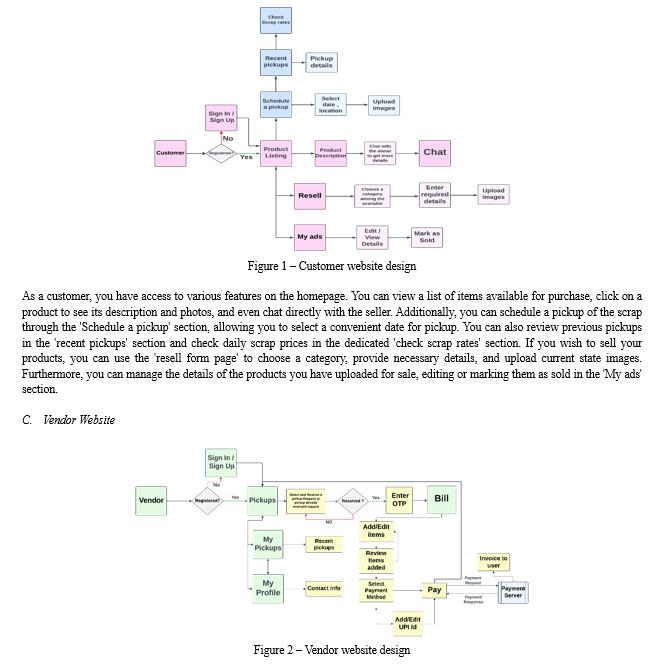
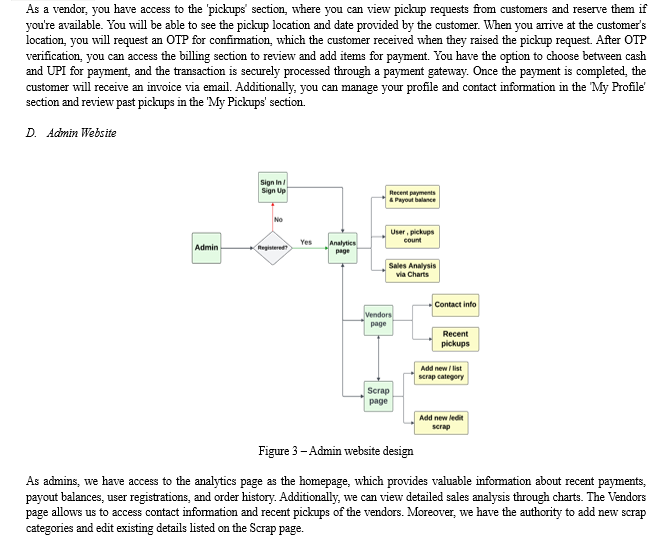
VI. IMPLEMENTATION & RESULTS
- Customer Side
1) Homepage
Scrapify's homepage offers an intuitive online marketplace where users can seamlessly buy and sell a diverse array of items. Whether one is in search of electronics, vehicles, or other commodities, Scrapify provides a convenient platform for users to connect and transact. ‘Browse by Categories’ Users have the flexibility to explore items based on specific categories, streamlining the search process to find items aligned with their preferences. The homepage prominently showcases fresh recommendations to captivate user’s attention. Newly listed items are prioritized, ensuring users are presented with the latest offerings. Moreover, recommendations are tailored based on the user's interests and browsing history, enhancing the personalized browsing experience. Scrapify implements pagination to facilitate navigation through recommendations. Each page displays up to 10 items, allowing users to efficiently browse listings. Navigation between pages is made easy with the next and previous buttons, enabling users to seamlessly explore available items. By offering a user-friendly interface, personalized recommendations, and efficient navigation tools, Scrapify strives to elevate the online buying and selling experience, fostering a dynamic marketplace environment.
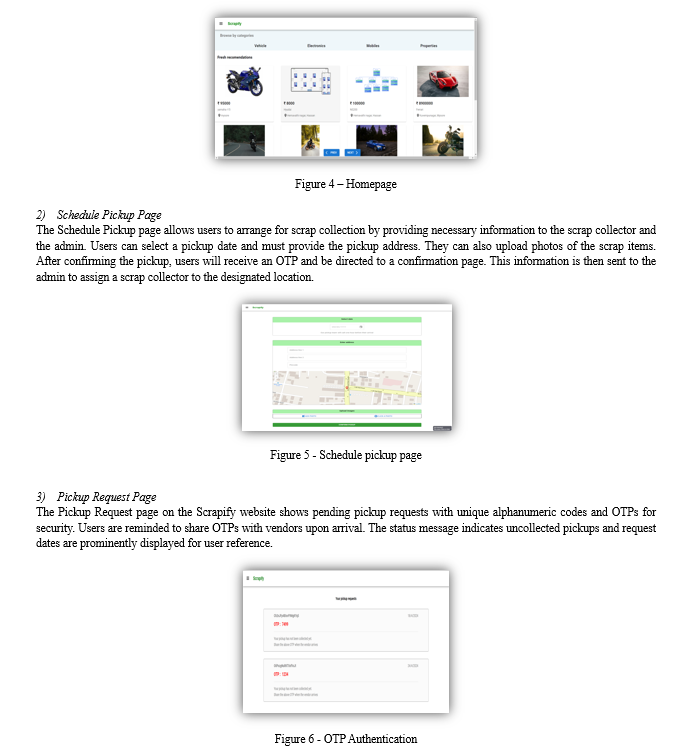

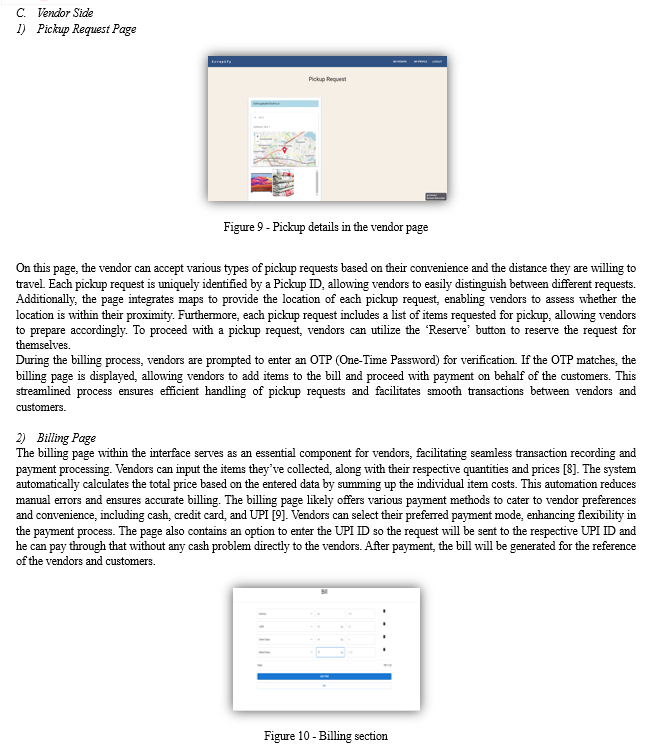
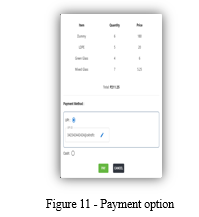
Conclusion
We have developed and deployed a website named Scrapify, where you can sell or recycle scraps. It is a user-friendly platform that provides doorstep pickup by our vendors. We offer the most competitive prices for the scrap you provide and charge reasonable fees for scrap recycling. Additionally, you can sell electronic appliances, vehicles, or any other scrap that is of no use to you and earn money from it. To ensure security, our website includes features such as authentication for logging in, and we provide an OTP when you request a pickup, which must be shared with our vendor. Scrap will only be collected if the OTP is correct. The vendor evaluates the scrap, assigns the amount to be paid to the customer, and then collects the scrap [10]. The customer will receive the payment and an invoice by email if the scrap is verified to be sold. If the customer wants to recycle the scrap, we have a fixed amount for particular scraps. Payment can be made through cash or a secure payment gateway option that we provide, ensuring security and integrity for the customers [11]. We chose to work on this topic after researching various papers and discussing real-world problems that can be solved digitally to benefit people and the environment. We believe waste management can be improved by organizing the flow of waste in the sector. In India, waste and scrap management is highly unorganized. The traditional kabadiwalas rarely visit urban areas nowadays. People who sell scrap to nearby vendors often receive unsatisfactory prices [12]. We aim to address these issues through our website. Overall, we are satisfied with taking on this project as it benefits the country and the environment in many ways. Our future development plans include integrating an ML model that can automatically detect the scrap and its category upon uploading a picture, as well as improving the user interface.
References
[1] Diyasha Sengupta, I.M.S.K. Ilankoon, Kai Dean Kang, Meng Nan Chong “Circular economy and household e-waste management in India. Part II: A case study on informal e-waste collectors (Kabadiwalas) in India” Minerals Engineering, Volume 200, September 2023, 108154, DOI: https://doi.org/10.1016/j.mineng.2023.108154 [2] Prajwal Ratnaparkhe, Tushar Wagh, Sojwal Ingale, Chaitnya Shelke “METRO CITY SCRAP MANAGEMENT SYSTEM” in IJARIIE, Vol-9 Issue-1 2023 [3] Rafiat Oyekunle, Arikewuyo Olawale Abdulgaffar “TRUST IN THE E-MARKET PLACE: A CASE STUDY OF OLX.Ng USERS” Conference: The 5th iSTEAMS Research Nexus Conference At: Afe Babalola University, Ado Ekiti, Ekiti State, Nigeria Volume: Vol. 5 pp 555-558 [4] Puneeth L Sankadal, A M Chandrashekhar, Prashanth Chillabatte “Network Security situation awareness system” International Journal of Advanced Research in Information and Communication Engineering (IJARICE), Volume 3, Issue 5, May 2015 [5] Koushik P, A M Chandrashekhar, Jagadeesh Takkalakaki, “Information security threats, awareness and cognizance” International Journal for Technical Research in Engineering (IJTRE), Volume 2, Issue 9, May 2015. [6] Yadunandan Huded, A M Chandrashekhar, Sachin Kumar H S, “Advances in Information security risk practices” International Journal of Advanced Research in data mining and Cloud computing (IJARDC), Volume 3, Issue 5 May 2015. [7] A M Chandrashekhar, Amrithesh, Vishal Rajkumar Naik, Vidyasagar M S, Adesha H “Placement Preparation Portal using REACT JS and Cloud Firebase”, International Journal of creative research taught (IJCRT), ISSN:2320-2882, Volume10, Issue 6 , June 2022. [8] Syed Tahseen Ahmed, A M Chandrashekhar, Rahul N, “Analysis of Security Threats to Database Storage Systems” International Journal of Advanced Research in data mining and Cloud computing (IJARDC), Volume 3, Issue 5, May. [9] Huda Mirza Saifuddin, A M Chandrashekhar, Spoorthi B S, “Exploration of the ingredients of original security” International Journal of Advanced Research in Computer Science and Applications (IJARCSA), Volume 3, Issue 5, May 2015. [10] Chandrashekhar A M, Naveen J., Chethana S., Charith S. (2020) Tackling Counterfeit Medicine Through an Automated System Integrated with QR Code. In: Hemanth J., Bestak R., Chen J.IZ. (eds) Intelligent Data Communication Technologies and Internet of Things. Lecture Notes on Data Engineering and Communications Technologies, vol 57. Springer, Singapore. https://doi.org/10.1007/978-981-15-9509-7_2 [11] Sowmyashree K K, A M Chandrashekhar, Sheethal R S, “Pyramidal aggregation on Communication security” International Journal of Advanced Research in Computer Science and Applications (IJARCSA), Volume 3, Issue 5, May 2015. [12] Prashanth G M, A M Chandrashekhar, Anjaneya Bulla, “Secured infrastructure for multiple group communication” International Journal of Advanced Research in Information and Communication Engineering (IJARICE), Volume 3, Issue 5, May 2015.
Copyright
Copyright © 2024 A M Chandrashekar, Rohan Achar V, S P Pratheek, Skanda Udupi, Prajwal S. This is an open access article distributed under the Creative Commons Attribution License, which permits unrestricted use, distribution, and reproduction in any medium, provided the original work is properly cited.

Download Paper
Paper Id : IJRASET62725
Publish Date : 2024-05-26
ISSN : 2321-9653
Publisher Name : IJRASET
DOI Link : Click Here
 Submit Paper Online
Submit Paper Online

